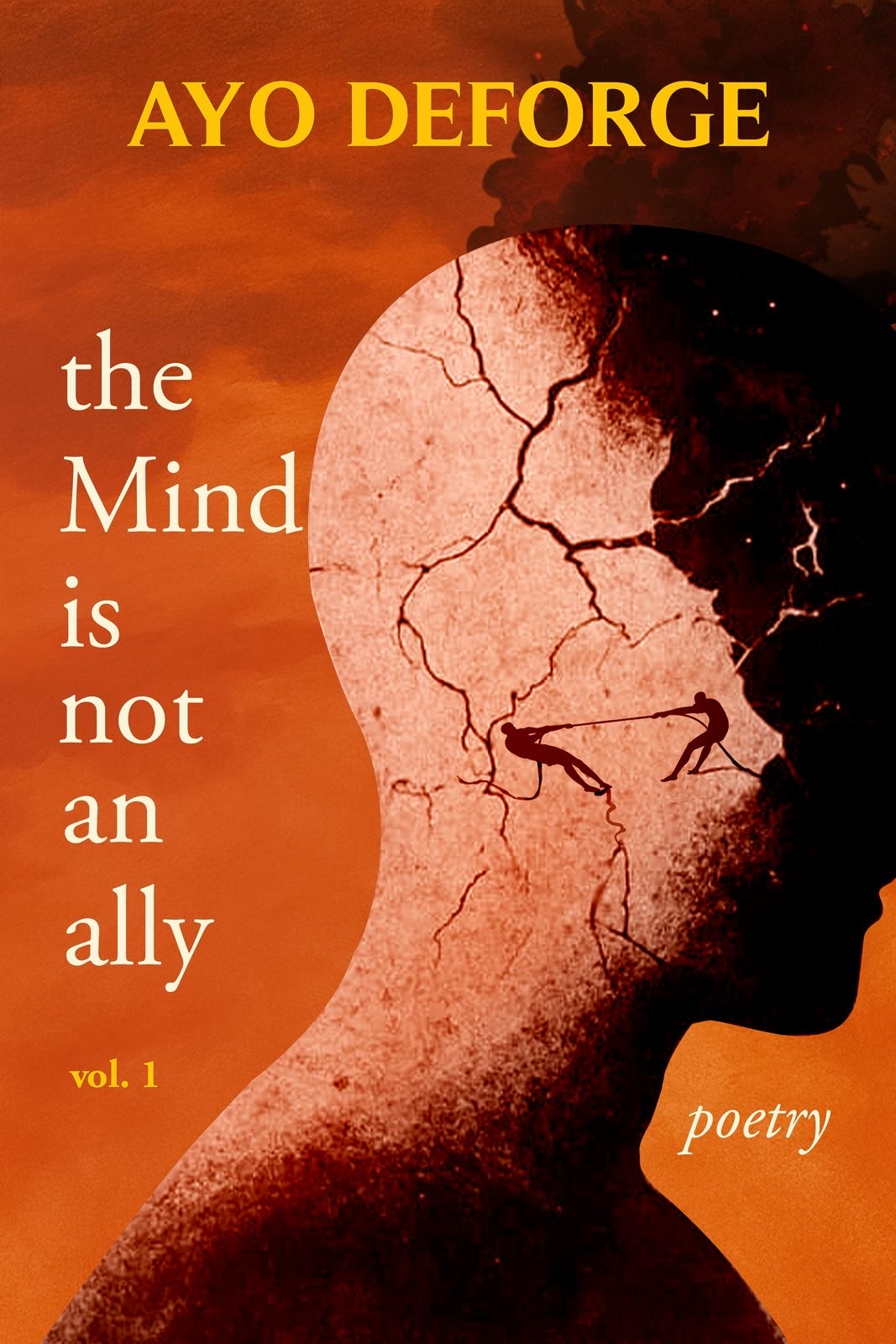Ayo Deforge’s central argument in The Mind Is Not An Ally is that the mind, though an integral part of human existence, is both ally and adversary.
By Evidence Egwuono Adjarho
The Greek historian and essayist, Plutarch, drew a compelling analogy between painting and poetry. He believed that art, even without words, instructs and reveals truths about human nature and emotion. This belief is perfectly encapsulated in his often quoted line: “Painting is silent poetry, and poetry is painting that speaks”.
In Ayo Deforge’s poetry collection, The Mind Is Not an Ally, Plutarch’s sentiment comes alive. The collection begins not with words but with artwork. The image is that of a woman whose face is drawn in visible irritation: brows furrowed, lips tight, eyes fixed on something unseen by the reader.
Around her, chaotic zigzag lines crisscross in restless motion, converging toward her figure as though the world itself trembles around her. Her hair, drawn in wild, unyielding waves, mirrors this disorder with each strand demanding attention. Together, these elements produce a palpable unease. The image becomes the collection’s first poem.

The Mind Is Not an Ally is born from a fusion of experiential insight and philosophical reflection. It is not merely a meditation on thought but also an anatomy of mental existence. The speaker throughout the collection is omniscient and detached, almost like an observer who has wrestled with the mind’s caprices and emerged with hard-won wisdom.
This persona speaks with an air of authority, which is firm, reflective, and at times, unsettlingly candid. What immediately stands out to readers is the poet’s stylistic choice. The word ‘Mind’ is consistently written as a proper noun, while most other words remain in lowercase. This typographical decision forces readers to confront the mind as a character rather than an abstract concept.
Ayo Deforge’s central argument in The Mind Is Not An Ally is that the mind, though an integral part of human existence, is both ally and adversary. It is sentient, unpredictable, and deeply persuasive. It is capable of creation but also of destruction. The collection explores the paradox of this duality. As the poet writes, the mind “speaks in a chorus of tongues, / each one vying to be heard”.
It is not a single voice but a crowd of impulses, a cacophony of thought and emotion. Left unchecked, the mind matures much like a human being, passing through stages of instability and arrogance: “cranky like a newborn, / fussy like a baby, / capricious like a toddler, / rebellious like a teenager, / headstrong like an adult, / and resolute like the aged.” This anthropomorphism makes readers recognise in it their own inner conflicts.
The mind, as the collection posits, operates independently of its host. It possesses its own will, often at odds with human intention. It manipulates, distracts, and creates illusions that blur the line between truth and perception.
Deforge suggests the mind is also a control freak; it despises confrontation and thrives on regression and illusion. In doing so, it endangers the individual, and erodes the self’s sense of agency. This tension between the thinker and the thought, the human and the mind, is the heartbeat of the book.

Structurally, The Mind Is Not an Ally is divided into five parts, with each probing a distinct facet of the Mind’s complexity. Though the divisions are clear, they do not function as isolated units but rather as interconnected explorations of the same philosophical terrain. Part I, titled “The Untamed Mind”, introduces readers to the mind’s raw, ungoverned state.
Here, the mind is not depicted as evil but as potent: “a lush garden”, “a fertile ground”, “a vast labyrinth.” Yet, this abundance is dangerous. The persona warns that “the Mind is not always an ally,” and without identity or direction, it becomes “a torrent of restless thoughts”. Left to its own devices, the mind seeks impersonation, desiring to “crown itself your master”.
The following sections deepen the exploration into specific expressions of the mind. “The Turbulence of the Emotional Mind” examines how the mind behaves when coloured by feelings. Here, the mind is stripped of its neutrality and made vulnerable to human passion. It is at once fragile and cunning: the “feeble Mind” that buckles under rejection, and the “unbridled Mind” that “weaves illusions of memory, / and threads them through the needle of déjà vu.” Deforge’s imagery here is vivid and psychological, especially as it transforms abstract emotion into concrete metaphor.
One of the most striking uses of language in The Mind Is Not An Alley occurs when the mind is likened to a courtroom, where guilt, fear, doubt, and shame serve as prosecutors. The self stands accused and is unable to escape judgment: “It will summon this trial again and again, until you are no longer your own”. The courtroom becomes a recurring mental theatre of self-punishment, which symbolises the way unresolved emotions perpetuate cycles of inner torment.
As the collection progresses, the reader begins to discern a shift. The earlier poems have imagery heavy with turbulence. But by Part V, “The Strength of the Disciplined Mind”, the tone softens into something akin to serenity. The accompanying artwork reinforces this shift.
The image is a woman with neatly packed hair, surrounded by patterns that resemble petals rather than the chaotic zigzags of the opening image. The chaos has been replaced by order, and entropy gives way to balance. Here, the speaker’s voice becomes intimate and instructive, addressing the reader directly. Noticeably, the tone transitions from philosophical observation to compassionate counsel.

Ayo Deforge’s poetic style is simple and sometimes prosaic. The diction favours clarity over flourish. Yet, the simplicity serves a purpose: it foregrounds the intensity of the imagery and the weight of the ideas. This is a book you cannot read in haste. As you read, you make mental notes, pause to affirm palatable points, or criticise those that are disagreeable. Whatever the case, the nature of The Mind Is Not an Ally is such that there is almost never a moment of stillness as your thoughts are constantly engaged.
Religious undertones run through the work. The very last two lines of the collection reads:
don’t just be mindful,
be Spirit-led.
Some readers may find these moments overly abstract, but they also deepen the work’s universality, placing Deforge’s collection within a broader human inquiry that spans psychology, spirituality, and art.
With The Mind Is Not an Ally, Ayo Deforge reminds readers that the Mind, though indispensable, must be mastered rather than obeyed. By the time the final poem in the collection ends, a truism emerges: the mind may not always be an ally, but understanding it is the beginning of peace.
Evidence Egwuono Adjarho is a dynamic and evolving creative with a flair for literature and the arts. She finds joy in reading and writing, and often spends her free time observing the world around her. Her interests span a wide range of artistic expressions, with a particular focus on storytelling in its many forms including photography.




